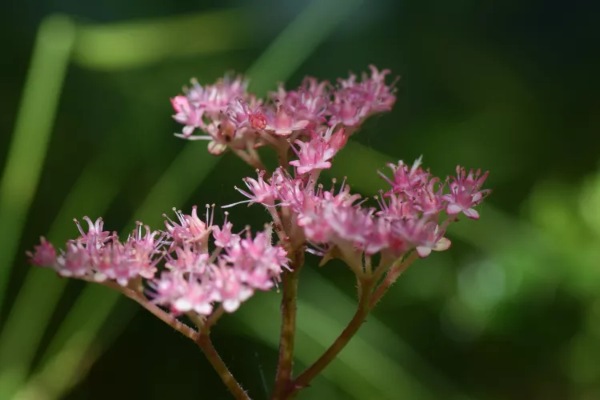Rodgersia which was once popular in nurseries and fine garden landscaping is now widely available at home gardens. This large, showy, flowering plant is the total package. It has eye-catching color-changing pinnate or palmate, basal leaves, to towering spikes that bear, white, cream, and pink flowers in spring and summer.
The Rodgeria genus consists of six species and several cultivars. Some even compare this plant to astilbe as it can grow up to 5 feet with more decoration in the foliage.
Known for its great adaptability to shady areas, this plant works well as a landscaping ground cover, in woodland gardens, water gardens, and streambeds. It also makes a bold statement at the back of flowerbeds.
- Common Name: Rodgersia, Featherleaf, Fingerleaf, Rodger’s Flower
- Botanical Name: Rodgersia spp
- Family: Saxifragaceae
- Plant Type: Herbaceous perennial
- Mature Size: 3 to 5 feet tall and wide
- Sun Exposure: Full sun to part shade
- Soil Type: Loam, sand, clay, moist but well-drained
- Soil pH: Neutral to slightly acidic or alkaline
- Bloom Time: Spring, Summer
- Flower Color: White, cream, pink, rose
- Hardiness Zone: USDA 5 to 7
- Native Areas: E. Asia, China, Japan, Korea
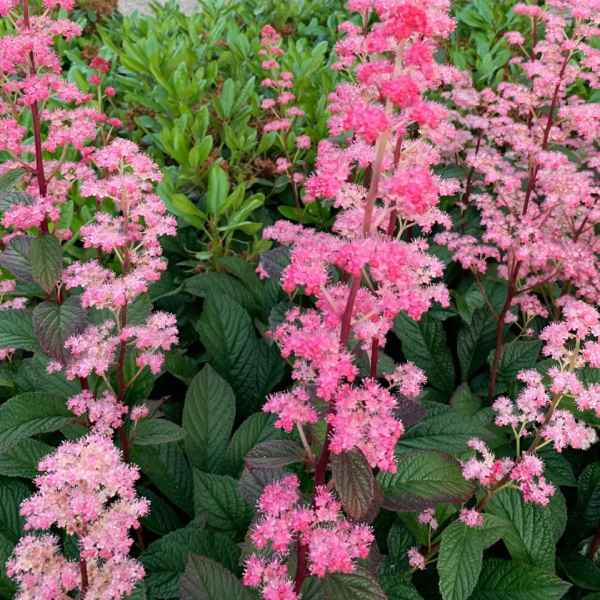
How to care for Rogersia?
You might think this plant is hard to care for. However, this is not the case. As long as it’s provided specific conditions, it is not that difficult to grow and care for it.
If you provide Rogersia with the correct location, plants will multiply gradually, eventually creating clumps of eyecatching, season-long foliage and flowers.
After five or six years, Rodgersia plants start to fade and give a straggly appearance. You can improve its performance by dividing, mature plants and removing old foliage. These are the following necessities of a healthy and happy Rogersia:
Light
If you want to get the most from your plant, you must provide it with the light it requires. Depending on the types of Rogersia you have, you need to know whether your plant requires full sun exposure of six hours daily or almost full shade of two to six hours daily. Varieties that grow in full sun require soil that stays moist all the time.
The light also affects the leaf color which often goes bronze in spring, changing to green in summer and turning brilliant shades of red and yellow in autumn.
Soil
Another important factor that affects the quality of the plant is the quality of its soil. These plants are moisture-loving species that are found naturally in bogs and wet places. They can do well in clay to sand but fertile loam encourages good health and performance of it. Soil pH from slightly acidic to slightly alkaline is good for growing Rodgersia.
Water
When first transplanting into the garden, you must water regularly. Keep in mind that these plants will not thrive without consistently moist soil. However, when grown in the correct location, watering is required only during periods of hot, dry weather. A place that prevents drying winds helps to improve air and soil moisture. You can layer mulch to keep the plants looking fresh until the cold arrives.
Temperature and Humidity
Rodgersia does best in cooler summers. While it can tolerate temperatures as high as 105°F, it acclimates better to temperatures between 65°F and 80°F.
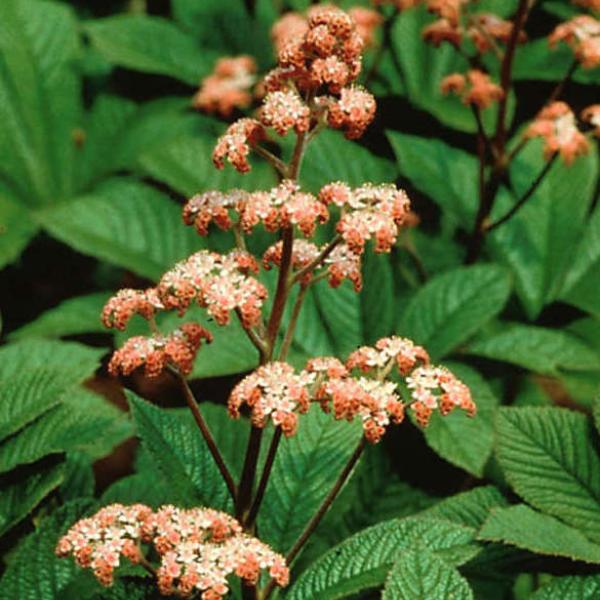
This perennial species dies back in autumn when the temperatures start dropping but roots are hardy at 15°F. If you live in a place with very cold winters, you can save it by protecting the roots with a layer of mulch. You can choose a location that shelters the plant from strong, drying winter winds to prevent plant loss.
Fertilizer
This plant gets extra nutrition from the application of general-purpose fertilizer in spring when new growth starts. An NPK 10-10-10 helps to promote the spread of the plant from the rhizome.
Types of Rodgersia
Rodgeria aesculifolia
This plant’s-palmate leaves are bright bronze in spring. It is 20 inches tall with 14-inch spikes of creamy white flowers.
Rodgeria Kupfermond
Pinnate leaves look deep red-bronze in spring. Pale pink flowers grow on 16-inch spikes and overall the plant can grow up to 36 inches tall.
Rodgersia podophylla ‘Smaradg’
In spring, the palmate leaves emerge bronze. When the plant gets 30 inches tall, it blooms 9-inch spikes with beautiful creamy white flowers.
Rodgersia ‘Badenweiter’
This plant grows up to 27 inches tall. In spring, it bears red-bronze palmate leaves with creamy white flowers on 2-foot spikes.
Rodgersia pinnata ‘Chocolate Wing
A 21-inch cultivar grows light pink and rose flowers on 6-inch spikes. Pinnate foliage looks bronze in spring.
Should we prune Rodgersia?
The foliage dies in autumn so remove that first. The flower spikes go on to produce red berries and can be left for autumn interest. However, you should cut it to the ground in late winter or when it turns brown.
How to propagate Rodgersia?
Rodgersia is propagated through division. These beautiful plants might not be long-lived but they are well-behaved when it comes to spread and have attractive clumping habits. You can maintain their look by dividing mature plants every three years when the spring arrives.
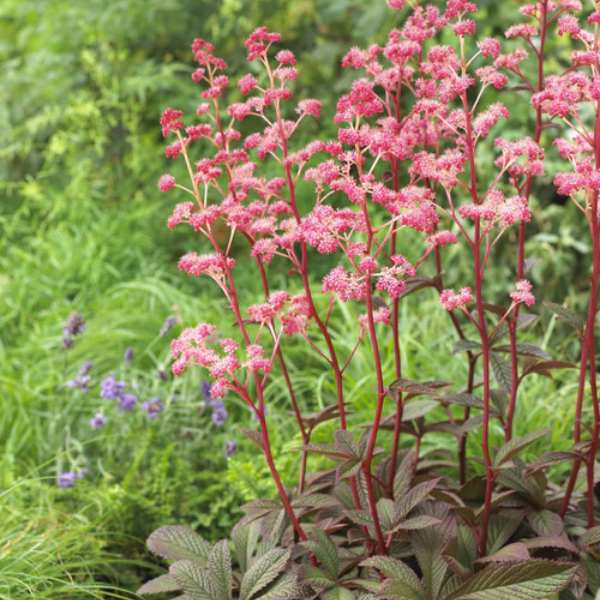
You can split large clumps and replant them right away. Just use a shovel or garden trowel to dig up a clump. Using a sharp knife or a saw, split it into two pieces.
Just remember, each section must have a good root system. Set plants at the same level as in their previous location.
Smaller divisions survive better if potted up and kept in a cold frame or greenhouse overwinter.
How to grow Rodgersia from seed?
If you’re planning to grow these amazing plants using seeds, remember that the seedlings require some babyling. These plants can take up to 3 years to mature and provide full color and bloom.
If you have a species plant, you can let the flowers have seed in autumn and start the next spring. Don’t be surprised if the cultivars may not produce a plant the same as the parent. Some varieties of seeds also require a cold stratification of 60 days.
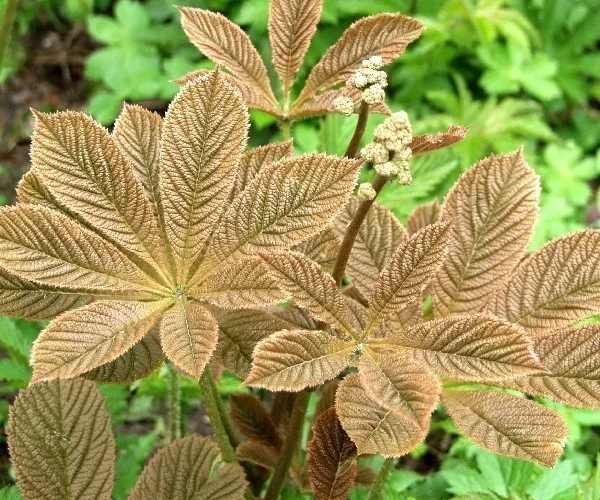
It might take two weeks to two months for seeds to germinate, depending on species and cultivar. You can grow the seedlings in a container for one year before transplanting them to an outdoor location.
Sow the seeds 1/4 inch deep in quality potting soil, and cover lightly. Ensure the location gets bright, indirect light and the soil is evenly moist. Gradually expose the seedlings to more light.
Potting and Repotting Rodgersia
Most Rodgersia are huge plants with a spreading rhizome and do well in the ground. If you are planning to grow it in a pot, pick a smaller variety and a larger container. The leaf and flower size will likely be smaller.
What do Rodgersia flowers look and smell like?
Rodgersia blooms look quite similar to astilbe and create dozens of small white, creamy white, pink, and rose blossoms. These flowers lack petals and are instead colored by sepals and stamens.
They have a soft, delicate, and floral smell.
Also Read: Embrace the Beauty of Spring: 10 Stunning Spring Flowers to Plant Now
FAQs
Q: What are some common problems with Rodgersia?
A: Some common problems are:
- Fail to bloom
- Wilt
- Foliage discoloration
Q: How big can Rodgersia plants get?
A: Rodgersia are large plants that form clumps with big, basal leaves and tall flower spikes. Plants range from 3 to 5 feet tall and wide with spikes that rise above the foliage from 6 inches to 6 feet.
Q: Are Rodgersia invasive?
A: Rodgersia is still not listed as an invasive plant. It does multiply but spreads slowly.
